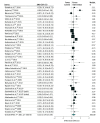Mobile Health Interventions for Improving Health Outcomes in Youth: A Meta-analysis
- PMID: 28319239
- PMCID: PMC6037338
- DOI: 10.1001/jamapediatrics.2017.0042
Mobile Health Interventions for Improving Health Outcomes in Youth: A Meta-analysis
Erratum in
-
Duplicate Sentence in Results Section.JAMA Pediatr. 2017 May 1;171(5):495. doi: 10.1001/jamapediatrics.2017.0948. JAMA Pediatr. 2017. PMID: 28460133 Free PMC article. No abstract available.
-
Citation Errors in Figure 2.JAMA Pediatr. 2018 Mar 1;172(3):302. doi: 10.1001/jamapediatrics.2017.5416. JAMA Pediatr. 2018. PMID: 29340563 Free PMC article. No abstract available.
Abstract
Importance: Mobile health interventions are increasingly popular in pediatrics; however, it is unclear how effective these interventions are in changing health outcomes.
Objective: To determine the effectiveness of mobile health interventions for improving health outcomes in youth 18 years or younger.
Data sources: Studies published through November 30, 2016, were collected through PubMed, Cumulative Index to Nursing and Allied Health Literature, Educational Resources Information Center, and PsychINFO. Backward and forward literature searches were conducted on articles meeting study inclusion criteria. Search terms included telemedicine, eHealth, mobile health, mHealth, app, and mobile application.
Study selection: Search results were limited to infants, children, adolescents, or young adults when possible. Studies were included if quantitative methods were used to evaluate an application of mobile intervention technology in a primary or secondary capacity to promote or modify health behavior in youth 18 years or younger. Studies were excluded if the article was an unpublished dissertation or thesis, the mean age of participants was older than 18 years, the study did not assess a health behavior and disease outcome, or the article did not include sufficient statistics. Inclusion and exclusion criteria were applied by 2 independent coders with 20% overlap. Of 9773 unique articles, 36 articles (containing 37 unique studies with a total of 29 822 participants) met the inclusion criteria.
Data extraction and synthesis: Of 9773 unique articles, 36 articles (containing 37 unique studies) with a total of 29 822 participants met the inclusion criteria. Effect sizes were calculated from statistical tests that could be converted to standardized mean differences. All aggregate effect sizes and moderator variables were tested using random-effects models.
Main outcomes and measures: Change in health behavior or disease control.
Results: A total of 29 822 participants were included in the studies. In studies that reported sex, the total number of females was 11 226 (53.2%). Of those reporting age, the average was 11.35 years. The random effects aggregate effect size of mobile health interventions was significant (n = 37; Cohen d = 0.22; 95% CI, 0.14-0.29). The random effects model indicated that providing mobile health intervention to a caregiver increased the strength of the intervention effect. Studies that involved caregivers in the intervention produced effect sizes (n = 16; Cohen d = 0.28; 95% CI, 0.18-0.39) larger than those that did not include caregivers (n = 21; Cohen d = 0.13; 95% CI, 0.02-0.25). Other coded variables did not moderate study effect size.
Conclusions and relevance: Mobile health interventions appear to be a viable health behavior change intervention modality for youth. Given the ubiquity of mobile phones, mobile health interventions offer promise in improving public health.
Conflict of interest statement
Figures


References
-
- Smith A. Chapter one: a portrait of smartphone ownership. PewResearchCenter. http://www.pewinternet.org/2015/04/01/chapter-one-a-portrait-of-smartpho.... Published April 1, 2015. Accessed September 10, 2016.
-
- Lenhart A. A majority of American teens report access to a computer, game console, smartphone, and a tablet. PewResearchCenter. http://www.pewinternet.org/2015/04/09/a-majority-of-american-teens-repor.... Published April 9, 2015. Accessed September 10, 2016.
-
- Rideout V. The common sense census: media use by tweens and teens. Common Sense Media. https://www.commonsensemedia.org/sites/default/files/uploads/research/ce.... Published 2015. Accessed September 10, 2016.
-
- Anglada-Martinez H, Riu-Viladoms G, Martin-Conde M, Rovira-Illamola M, Sotoca-Momblona JM, Codina-Jane C. Does mHealth increase adherence to medication? results of a systematic review. Int J Clin Pract. 2015;69(1):9-32. - PubMed
Publication types
MeSH terms
LinkOut - more resources
Full Text Sources
Other Literature Sources
Medical
Miscellaneous

